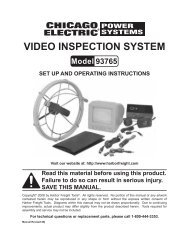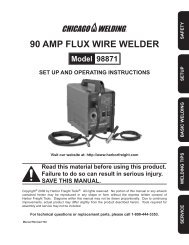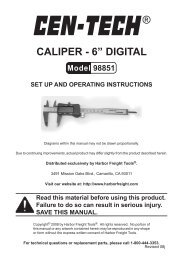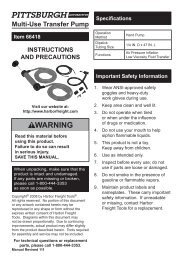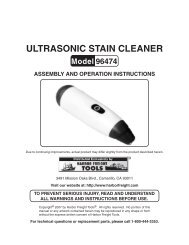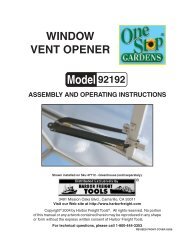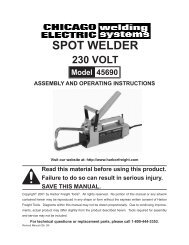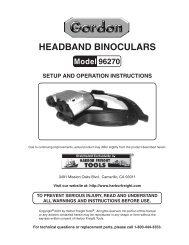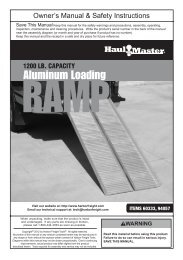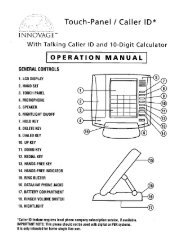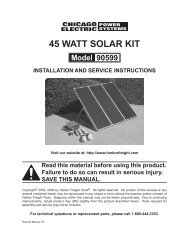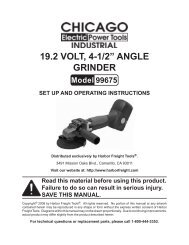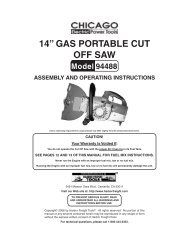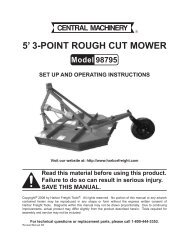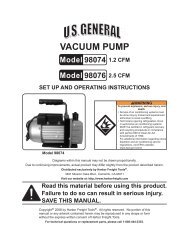18v cordless combo pack - Harbor Freight Tools
18v cordless combo pack - Harbor Freight Tools
18v cordless combo pack - Harbor Freight Tools
Create successful ePaper yourself
Turn your PDF publications into a flip-book with our unique Google optimized e-Paper software.
18V CORDLESS COMBO PACK<br />
Model 90374<br />
ASSEMBLY AND OPERATING INSTRUCTIONS<br />
Due to continuing improvements,<br />
actual product may differ slightly from the product described herein.<br />
Distributed exclusively by<br />
<strong>Harbor</strong> <strong>Freight</strong> <strong>Tools</strong> ® .<br />
3491 Mission Oaks Blvd., Camarillo, CA 93011<br />
Visit our Web site at: http://www.harborfreight.com<br />
Copyright © 2003 by <strong>Harbor</strong> <strong>Freight</strong> <strong>Tools</strong> ® . All rights reserved. No portion of this<br />
manual or any artwork contained herein may be reproduced in any shape or form<br />
without the express written consent of <strong>Harbor</strong> <strong>Freight</strong> <strong>Tools</strong>.<br />
For technical questions, please call 1-800-444-3353.<br />
REV 07l
PRODUCT SPECIFICATIONS<br />
Item<br />
Electrical Requirements<br />
Battery<br />
Charging Time<br />
Drill Specifications<br />
Oscillating Sander<br />
Specifications<br />
Flashlight Specifications<br />
Jigsaw Specifications<br />
Accessories<br />
Weight<br />
Description<br />
Batter Charger Input: 120 VAC / 60 Hz<br />
Battery Output: 18 VDC<br />
3 to 5 Hours<br />
3/8" Keyless / Reversible / Single Speed / 900 RPM<br />
Squeeze Trigger / Torque Adjustments: 1 - 8<br />
Triangle Shape / Hook & Loop Attachment<br />
6,000 OPM / Rocker Power Switch<br />
Pistol Grip / 0 - 90 Degree Swivel Head / Slider Power Switch<br />
Stepped Lens (Clear) / 8 Watt Bulb<br />
1/2" Stroke / 1,700 SPM / One Speed / Squeeze Trigger<br />
Safety Lock / Blade Guard / Angle Adjustable<br />
Rechargeable 18 VDC Battery / Battery Charger<br />
13.40 Pounds<br />
SAVE THIS MANUAL<br />
You will need this manual for the safety warnings and precautions, assembly,<br />
operating, inspection, maintenance and cleaning procedures, parts list and assembly<br />
diagram. Keep your invoice with this manual. Write the invoice number<br />
on the inside of the front cover. Keep this manual and invoice in a safe and dry<br />
place for future reference.<br />
GENERAL SAFETY RULES<br />
WARNING!<br />
READ AND UNDERSTAND ALL INSTRUCTIONS<br />
Failure to follow all instructions listed below may result in<br />
electric shock, fire, and/or serious injury.<br />
SAVE THESE INSTRUCTIONS<br />
WORK AREA<br />
1. Keep your work area clean and well lit. Cluttered benches and dark areas<br />
invite accidents.<br />
2. Do not operate power tools in explosive atmospheres, such as in the<br />
presence of flammable liquids, gases, or dust. Power tools create sparks<br />
which may ignite the dust or fumes.<br />
SKU 90374 PAGE 2 REV 05g, 07l
3. Keep bystanders, children, and visitors away while operating a power tool.<br />
Distractions can cause you to lose control. Protect others in the work area from<br />
debris such as chips and sparks. Provide barriers or shields as needed.<br />
ELECTRICAL SAFETY<br />
4. Grounded tools must be plugged into an outlet properly installed and<br />
grounded in accordance with all codes and ordinances. Never remove the<br />
grounding prong or modify the plug in any way. Do not use any adapter<br />
plugs. Check with a qualified electrician if you are in doubt as to whether<br />
the outlet is properly grounded. If the tools should electrically malfunction or<br />
break down, grounding provides a low resistance path to carry electricity away<br />
from the user.<br />
5. Double insulated tools are equipped with a polarized plug (one blade is<br />
wider than the other). This plug will fit in a polarized outlet only one way. If<br />
the plug does not fit fully in the outlet, reverse the plug. If it still does not<br />
fit, contact a qualified electrician to install a polarized outlet. Do not<br />
change the plug in any way. Double insulation eliminates the need for the<br />
three wire grounded power cord and grounded power supply system.<br />
6. Avoid body contact with grounded surfaces such as pipes, radiators,<br />
ranges, and refrigerators. There is an increased risk of electric shock if your<br />
body is grounded.<br />
7. Do not expose power tools to rain or wet conditions. Water entering a power<br />
tool will increase the risk of electric shock.<br />
8. Do not abuse the Power Cord. Never use the Power Cord to carry the tools<br />
or pull the Plug from an outlet. Keep the Power Cord away from heat, oil,<br />
sharp edges, or moving parts. Replace damaged Power Cords immediately.<br />
Damaged Power Cords increase the risk of electric shock.<br />
9. When operating a power tool outside, use an outdoor extension cord<br />
marked “W-A” or “W”. These extension cords are rated for outdoor use, and<br />
reduce the risk of electric shock.<br />
PERSONAL SAFETY<br />
10. Stay alert. Watch what you are doing, and use common sense when<br />
operating a power tool. Do not use a power tool while tired or under the<br />
influence of drugs, alcohol, or medication. A moment of inattention while<br />
operating power tools may result in serious personal injury.<br />
SKU 90374 PAGE 3
11. Dress properly. Do not wear loose clothing or jewelry. Contain long hair.<br />
Keep your hair, clothing, and gloves away from moving parts. Loose<br />
clothes, jewelry, or long hair can be caught in moving parts.<br />
12. Avoid accidental starting. Be sure the Power Switch is off before plugging<br />
in. Carrying power tools with your finger on the Power Switch, or plugging in<br />
power tools with the Power Switch on, invites accidents.<br />
13. Remove adjusting keys or wrenches before turning the power tool on. A<br />
wrench or a key that is left attached to a rotating part of the power tool may result<br />
in personal injury.<br />
14. Do not overreach. Keep proper footing and balance at all times. Proper<br />
footing and balance enables better control of the power tool in unexpected<br />
situations.<br />
15. Use safety equipment. Always wear eye protection. Dust mask, non-skid<br />
safety shoes, hard hat, or hearing protection must be used for appropriate<br />
conditions.<br />
TOOL USE AND CARE<br />
16. Use clamps (not included) or other practical ways to secure and support<br />
the workpiece to a stable platform. Holding the work by hand or against your<br />
body is unstable and may lead to loss of control.<br />
17. Do not force the tool. Use the correct tool for your application. The correct<br />
tool will do the job better and safer at the rate for which it is designed.<br />
18. Do not use the power tool if the Power Switch does not turn it on or off.<br />
Any tool that cannot be controlled with the Power Switch is dangerous and must<br />
be replaced.<br />
19. Disconnect the Battery from the tool before making any adjustments,<br />
changing accessories, or storing the tool. Such preventive safety measures<br />
reduce the risk of starting the tool accidentally.<br />
20. Store idle tools out of reach of children and other untrained persons. <strong>Tools</strong><br />
are dangerous in the hands of untrained users.<br />
21. Maintain tools with care. Keep cutting tools sharp and clean. Properly<br />
maintained tools with a sharp cutting edge are less likely to bind and are easier<br />
to control. Do not use a damaged tool. Tag damaged tools “Do not use” until<br />
repaired.<br />
SKU 90374 PAGE 4 REV 03j
22. Check for misalignment or binding of moving parts, breakage of parts, and<br />
any other condition that may affect the tool’s operation. If damaged, have<br />
the tool serviced before using. Many accidents are caused by poorly maintained<br />
tools.<br />
23. Use only accessories that are recommended by the manufacturer for your<br />
model. Accessories that may be suitable for one tool may become hazardous<br />
when used on another tool.<br />
SERVICE<br />
24. Tool service must be performed only by qualified repair personnel. Service<br />
or maintenance performed by unqualified personnel could result in a risk of injury.<br />
25. When servicing a tool, use only identical replacement parts. Follow<br />
instructions in the “Inspection, Maintenance, And Cleaning” section of this<br />
manual. Use of unauthorized parts or failure to follow maintenance instructions<br />
may create a risk of electric shock or injury.<br />
GROUNDING<br />
WARNING!<br />
Improperly connecting the grounding wire can result in the risk of electric shock.<br />
Check with a qualfified electrician if you are in doubt as to whether the outlet is<br />
properly grounded. Do not modify the power cord plug provided with the tool.<br />
Never remove the grounding prong from the plug. Do not use the tool if the power<br />
cord or plug is damaged. If damaged, have it repaired by a service facility before<br />
use. If the plug will not fit the outlet, have a proper outlet installed by a qualified<br />
electrician.<br />
SKU 90374 PAGE 5<br />
REV 03j
DOUBLE INSULATED TOOLS: TOOLS WITH TWO PRONG PLUGS<br />
1. <strong>Tools</strong> marked “Double Insulated” do not require grounding. They have a special<br />
double insulation system which satisfies OSHA requirements and complies with<br />
the applicable standards of Underwriters Laboratories, Inc., the Canadian<br />
Standard Association, and the National Electrical Code. (See Figure B.)<br />
2. Double insulated tools may be used in either of the 120 volt outlets shown in the<br />
following illustration. (See Figure B.)<br />
FIGURE B<br />
EXTENSION CORDS<br />
1. Grounded tools require a three wire extension cord. Double Insulated tools<br />
can use either a two or three wire extension cord.<br />
2. As the distance from the supply outlet increases, you must use a heavier gauge<br />
extension cord. Using extension cords with inadequately sized wire causes a<br />
serious drop in voltage, resulting in loss of power and possible tool damage.<br />
(See Figure C, below.)<br />
3. The smaller the gauge number of the wire, the greater the capacity of the cord.<br />
For example, a 14 gauge cord can carry a higher current than a 16 gauge cord.<br />
(See Figure C.)<br />
4. If using more than one extension cord to make up the total length, make sure<br />
each cord contains at least the minimum wire size required. (See Figure C.)<br />
SKU 90374 PAGE 6 REV 03j
5. If you are using one extension cord for more than one tool, add the nameplate<br />
amperes and use the sum to determine the required minimum cord size.<br />
(See Figure C.)<br />
6. If you are using an extension cord outdoors, make sure it is marked with the<br />
suffix “W-A” (“W” in Canada) to indicate it is acceptable for outdoor use.<br />
7. Make sure your extension cord is properly wired and in good electrical condition.<br />
Always replace a damaged extension cord or have it repaired by a qualified<br />
electrician before using it.<br />
8. Protect your extension cords from sharp objects, excessive heat, and damp or<br />
wet areas.<br />
RECOMMENDED MINIMUM WIRE GAUGE FOR EXTENSION CORDS*<br />
(120 VOLT)<br />
NAMEPLATE<br />
EXTENSION CORD LENGTH<br />
AMPERES<br />
(At Full Load)<br />
25<br />
Feet<br />
50<br />
Feet<br />
75<br />
Feet<br />
100<br />
Feet<br />
150<br />
Feet<br />
0 – 2.0 18 18 18 18 16<br />
2.1 – 3.4 18 18 18 16 14<br />
3.5 – 5.0 18 18 16 14 12<br />
5.1 – 7.0 18 16 14 12 12<br />
7.1 – 12.0 18 14 12 10 -<br />
12.1 – 16.0 14 12 10 - -<br />
16.1 – 20.0 12 10 - - -<br />
* Based on limiting the line voltage drop<br />
FIGURE C<br />
to five volts at 150% of the rated amperes.<br />
SKU 90374 PAGE 7
SYMBOLOGY<br />
Double Insulated<br />
V ~<br />
A<br />
noxxxx/min.<br />
Canadian Standards<br />
Association<br />
Underwriters<br />
Laboratories, Inc.<br />
Volts Alternating Current<br />
Amperes<br />
No Load Revolutions<br />
per Minute (RPM)<br />
SPECIFIC SAFETY RULES<br />
1. Maintain a safe working environment. Keep the work area well lit. Make sure<br />
there is adequate surrounding workspace. Always keep the work area free of<br />
obstructions, grease, oil, trash, and other debris. Do not use the Combo Pack in<br />
areas near flammable chemicals, dusts, and vapors.<br />
2. Maintain labels and nameplates on the Combo Pack. These carry<br />
important information. If unreadable or missing, contact <strong>Harbor</strong> <strong>Freight</strong> <strong>Tools</strong> for<br />
a replacement.<br />
3. Ground this product. To comply with the National Electric Code, and to provide<br />
additional protection from the risk of electrical shock, the Battery Charger (1B)<br />
should only be connected to a 120 volt electrical outlet that is protected by a<br />
Ground Fault Circuit Interrupter (GFCI).<br />
4. When using a hand-held power tool, always maintain a firm grip on the tool<br />
with both hands.<br />
5. To avoid electrical shock, do not pull or carry the Battery Charger/Charger<br />
Base (1B, 1C) by its Power Cord or pull the Power Cord around sharp<br />
corners or edges. Do not unplug the Battery Charger by pulling on the Power<br />
Cord. Keep the Power Cord away from heated surfaces.<br />
6. Never leave the Battery Charger (1B) unattended when it is plugged into an<br />
electrical outlet. Make sure to unplug the Battery Charger from its outlet before<br />
leaving.<br />
SKU 90374 PAGE 8<br />
REV 04f
7. Use eye protection. Always wear ANSI approved safety impact eye goggles<br />
when working with these products.<br />
8. Proper Battery Care: Battery (1A) leakage may occur under extreme usage or<br />
temperature conditions. If Battery fluid comes in contact with skin, wash with soap<br />
and water and rinse with lemon juice and vinegar. If the fluid comes in contact<br />
with eyes, flush with water for several minutes and contact a doctor immediately.<br />
Never burn the Battery, as it can explode in a fire. Do not attempt to charge a<br />
leaking Battery. Contact local solid waste authorities for instructions on correct<br />
disposal or recycling of the Battery.<br />
9. Do not allow children to handle or play with these products.<br />
10. Store idle equipment. When not in use, tools and equipment should be stored<br />
in a dry location to inhibit rust. Always lock up tools and equipment, and keep out<br />
of reach of children.<br />
11. Do not use these products if under the influence of alcohol or drugs. Read<br />
warning labels on prescriptions to determine if your judgement or reflexes are<br />
impaired while taking drugs. If there is any doubt, do not attempt to use these<br />
products.<br />
12. Industrial applications must follow OSHA requirements.<br />
13. Maintain this product with care. Keep these products clean and dry for better<br />
and safer performance.<br />
14. Maintenance: For your safety, service and maintenance should be performed<br />
regularly by a qualified technician.<br />
15. Check for damaged parts. Before using these products, carefully check that<br />
they will operate properly and perform their intended function. Check for<br />
damaged parts and any other conditions that may affect the safe operation of<br />
these products. Replace or repair damaged or worn parts immediately.<br />
16. Replacement parts and accessories: When servicing, use only identical<br />
replacement parts. Only use accessories intended for use with this product.<br />
17. Use the right tool or attachment for the right job. Do not attempt to force a<br />
small tool or attachment to do the work of a larger industrial tool or attachment.<br />
There are certain applications for which these products were designed. They will<br />
do the job better and more safely at the rate for which they were intended. Do<br />
not modify these products, and do not use these products for a purpose for which<br />
they were not intended.<br />
SKU 90374 PAGE 9
18. WARNING! Some dust created by power sanding, sawing, grinding, drilling,<br />
and other construction activities, contain chemicals known (to the State of<br />
California) to cause cancer, birth defects or other reproductive harm. Some<br />
examples of these chemicals are: lead from lead-based paints, crystalline silica<br />
from bricks and cement or other masonry products, arsenic and chromium from<br />
chemically treated lumber. Your risk from these exposures varies, depending on<br />
how often you do this type of work. To reduce your exposure to these chemicals:<br />
work in a well ventilated area, and work with approved safety equipment, such as<br />
those dust masks that are specially designed to filter out microscopic particles.<br />
(California Health & Safety Code 25249.5, et seq.)<br />
19. WARNING! People with pacemakers should consult their physician(s)<br />
before using this product. Operation of electrical equipment in close proximity to<br />
a heart pacemaker could cause interference or failure of the pacemaker.<br />
20. WARNING! The warnings, precautions, and instructions discussed in this<br />
manual cannot cover all possible conditions and situations that may occur. The<br />
operator must understand that common sense and caution are factors which<br />
cannot be built into this product, but must be supplied by the operator.<br />
UNPACKING<br />
When un<strong>pack</strong>ing, check to make sure all the parts shown on the Parts Lists on pages 18,<br />
19, 20, and 21 are included. If any parts are missing or broken, please call <strong>Harbor</strong> <strong>Freight</strong><br />
<strong>Tools</strong> at the number shown on the cover of this manual as soon as possible.<br />
ASSEMBLY AND OPERATING INSTRUCTIONS<br />
NOTE: For additional information regarding the parts mentioned in the following pages,<br />
refer to the Assembly Diagrams on pages 18, 19, 20, and 22.<br />
1. NOTE: The Battery (1A) requires charging. The first charge requires 5 hours<br />
charge time prior to using a <strong>cordless</strong> tool. (See Figure D, next page.)<br />
2. The Battery (1A) should only be re-charged when the Flashlight Bulb (7C) begins to<br />
dim or a <strong>cordless</strong> tool begins to run slowly. (See Figure D.)<br />
3. When the Battery (1A) requires re-charging, a 3 to 5 hour charge allows the tool<br />
to operate at full power. Do not re-charge the Battery longer than 5 hours, as<br />
damage to the Battery and/or Flashlight or <strong>cordless</strong> tool will occur.<br />
(See Figure D.)<br />
SKU 90374 PAGE 10
4. To charge the Battery (1A), plug the Battery Charger’s Plug (1B) into the Charging<br />
Base (1C). Plug the Battery (1A) into the Charging Base (1C). Charging room<br />
temperature: 50° F - 104° F. Then, plug the Battery Charger into the nearest 120<br />
Volt, grounded, electrical outlet. (See Figure D).<br />
5. A Charging Indicator Light on the Charging Base (1C) will illuminate to show that<br />
charging is taking place. NOTE: The Battery Charger (1B) will not automatically<br />
turn off when the Battery is fully charged, and the Charging Indicator Light will<br />
remain on until the Battery Charger is disconnected from the electrical outlet.<br />
Recharging the Battery more than 5 hours can cause damage to the battery cells.<br />
(See Figure D.)<br />
6. While charging, the Battery (1A), Battery Charger (1B), and/or Charger Base (1C)<br />
may become warm to the touch. This is normal, and does not indicate a problem.<br />
(See Figure D.)<br />
7. Once the Battery (1A) is fully charged, disconnect the Battery Charger (1B) from<br />
the electrical outlet. Then, disconnect the Battery from the Charging Base.<br />
(See Figure D.)<br />
BATTERY CHARGER (1B)<br />
Note: Always switch to a fresh battery when tool performance<br />
begins to diminish. Severe heat is most destructive to a battery; the<br />
more heat generated, the faster the battery loses power. A battery that<br />
gets too hot can be permanently damaged. Never over-discharge a<br />
battery by using the tool even after tool performance is decreasing.<br />
Never attempt to discharge a tool’s battery by continuing to pull the tool<br />
trigger. When tool performance begins to diminish, stop the tool,<br />
re-charge the battery and use the fresh battery for optimal<br />
performance.<br />
CHARGING INDICATOR LIGHT<br />
PLUG BATTERY CHARGER<br />
ONLY INTO A<br />
120 VOLT, GROUNDED,<br />
ELECTRICAL OUTLET.<br />
CHARGING BASE (1C)<br />
FIGURE D<br />
CHARGER PLUG<br />
To Operate The Flashlight:<br />
1. Insert the fully charged Battery (1A) in the Flashlight’s Handle, and make sure the<br />
Spring on the Battery snaps into place on the Handle.<br />
(See Figure E, next page.)<br />
2. Slide the Switch Button (4C) on the Handle forward to turn “ON”. (See Figure E.)<br />
SKU 90374 PAGE 11<br />
REV 03j, 04f, 07k
3. To turn off the Flashlight, slide the Switch Button (4C) to its OFF position.<br />
(See Figure E.)<br />
4. To change the Bulb (7C), unscrew the Light Head Cap (9C) and remove the Lens<br />
(8C). Remove the old Bulb by pushing in on the Bulb while turning it clockwise.<br />
Insert a new Bulb by aligning the tabs on the Bulb with the slots in the Bulb<br />
socket. Push in on the new Bulb while turning it counterclockwise. Re-attach the<br />
Lens and Light Head Cap. (See Figure E.)<br />
BATTERY (1A)<br />
LIGHT<br />
HEAD<br />
CAP<br />
(9C)<br />
LENS<br />
(8C)<br />
FLASHLIGHT<br />
HANDLE<br />
SWITCH<br />
BUTTON<br />
(4C)<br />
BULB<br />
(7C)<br />
FIGURE E<br />
To Operate The Sander:<br />
1. WARNING! The Cordless Sander is not designed for wet sanding.<br />
2. Make sure the Battery (1A) is disconnected from the Sander prior to attaching<br />
sand paper (not included) to the tool.<br />
3. To attach sand paper to the Sander, use the hook and loop mechanism on its<br />
Sand Paper Pad (17D). (See Figure F, next page.)<br />
4. Whenever possible, secure the workpiece that is to be sanded in a vise or with<br />
clamps.<br />
5. Insert the fully charged Battery (1A) in the Sander’s Handle, and make sure the<br />
Spring on the Battery snaps into place on the Handle. (See Figure F.)<br />
6. To turn on the Sander, squeeze the Switch (3D). NOTE: Always grip the Sander<br />
firmly with both hands when the tool is running.<br />
SKU 90374 PAGE 12
7. Lightly apply the oscillating Sand Paper Pad (17D) to the workpiece surface, and<br />
begin sanding the workpiece by moving the tool forward and backward with<br />
(parallel to) the grain of the workpiece.<br />
8. Once the sanding job is completed, release pressure on the Switch (3D) to turn off<br />
the Sander. (See Figure F.)<br />
9. IMPORTANT: If, during the sanding process it becomes necessary to replace<br />
worn sand paper with new sand paper, make sure to turn off the Sander and<br />
disonnect the Battery (1A). Re-install new sand paper and then re-attach the<br />
Battery. (See Figure F.)<br />
SANDER<br />
HANDLE<br />
SAND PAPER<br />
PAD<br />
(17D)<br />
SWITCH<br />
(3D)<br />
SANDER HANDLE<br />
FIGURE F<br />
BATTERY (1A)<br />
BATTERY (1A)<br />
To Operate The Jigsaw:<br />
1. Make sure the Battery (1A) is disconnected from the Jigsaw prior to attaching the<br />
Saw Blade (16E) to the tool.<br />
2. To attach the Saw Blade (16E) to the Jigsaw, use the Hex Key (24E) to loosen the<br />
two Hex Socket Screws (14E). (See Figure G, next page.)<br />
3. Insert the shank of the Saw Blade (16E) upward into the Blade Holder (15E) with<br />
its saw teeth pointing to the front of the tool. Then, re-tighten the two Hex Socket<br />
Screws (14E) to secure the Saw Blade in place. (See Figure G.)<br />
4. If desired, the angle of a cut may be adjusted. To do so, loosen the Hex Socket<br />
Screw (14E) located on the underside of the Sander. Tilt the Base Plate (19) to<br />
the desired angle. Then, re-tighten the Hex Socket Screw. (See Figure G.)<br />
SKU 90374 PAGE 13
5. Whenever possible, secure the workpiece that is to be cut in a vise or with<br />
clamps.<br />
6. Insert the fully charged Battery (1A) in the Jigsaw’s Handle, and make sure the<br />
Spring on the Battery snaps into place on the Handle.<br />
(See Figure G.)<br />
7. The Jigsaw is equipped with a Safety Button that prevents accidental starting. To<br />
turn on the Jigsaw, depress the Safety Button and then squeeze the Switch (5E).<br />
NOTE: Always grip the Jigsaw firmly with both hands when the tool is running.<br />
(See Figure G.)<br />
8. WARNING! Always keep hands and fingers away from the moving Saw<br />
Blade (16E). (See Figure G.)<br />
9. Lightly feed the Saw Blade (16E) into the workpiece and apply light, gradual,<br />
forward, pressure on the Jigsaw to move the tool along the area to be cut.<br />
10. Do not attempt to back out of an uncompleted cut while the Jigsaw is running. If<br />
necessary, release pressure on the Switch (5E) to turn off the Jigsaw. Then,<br />
remove the tool from the workpiece. (See Figure G.)<br />
11. IMPORTANT: If, during the cutting process it becomes necessary to replace a<br />
bent or broken Saw Blade (16E) with a new Saw Blade, or re-adjust the angle of<br />
the Base Plate (19E), make sure to turn off the Jigsaw and disonnect the Battery<br />
(1A). Re-install a new Saw Blade, or re-adjust the Base Plate, and then re-attach<br />
the Battery. (See Figure G.)<br />
HEX KEY<br />
(24E)<br />
HEX<br />
SOCKET<br />
SCREW<br />
(14E)<br />
HEX<br />
SOCKET<br />
SCREW<br />
(14E)<br />
SAW<br />
BLADE<br />
(16E)<br />
HEX KEY<br />
(24E)<br />
SAFETY<br />
BUTTON<br />
SWITCH<br />
(5E)<br />
FIGURE G<br />
BASE<br />
PLATE<br />
(19E)<br />
HANDLE<br />
BATTERY<br />
(1A)<br />
SKU 90374 PAGE 14
To Operate The Drill:<br />
1. WARNING! Always make sure the Trigger (3F) of the Cordless Drill is in its<br />
“OFF” position, the Battery (1A) is removed from the Drill, and the Battery<br />
Charger (1B) is unplugged from its electrical outlet prior to making any<br />
adjustments to the tool. (See Figure H.)<br />
2. The Chuck (12F): Accepts up to 3/8” diameter drill bits (not included) and the<br />
Screwdriver Bit (31F). To install a drill bit, hold the Chuck Sleeve firmly in place<br />
and turn the Chuck (12F) counterclockwise. Insert the shank of a drill bit all the<br />
way into the Chuck. While holding the Chuck Sleeve in place, turn the Chuck<br />
clockwise to lock the drill bit in place. (See Figure H.)<br />
3. The Trigger (3F): The Trigger is operated manually simply by squeezing the<br />
Trigger to turn on the Drill and releasing pressure on the Trigger to turn off the<br />
Drill. (See Figure H.)<br />
4. The Rotation Button (33F): The Rotation Button allows you to change the<br />
rotational direction of the Drill. For a clockwise rotation, move the Rotation<br />
Button to the right. For a counterclockwise rotation, move the Rotation<br />
Button to the left. (See Figure H.)<br />
5. The Torque Setting Ring (8F): The Torque Setting Ring allows you to select<br />
up to eight different driving torque settings, depending on the job required. To<br />
change the driving torque, simply turn the Torque Setting Ring to the desired setting.<br />
(See Figure D.)<br />
CHUCK SLEEVE<br />
CHUCK (12F)<br />
TORQUE SETTING RING (8F)<br />
ROTATION BUTTON (33F)<br />
TRIGGER (3F)<br />
DRILL HANDLE<br />
BATTERY (1A)<br />
FIGURE H<br />
SKU 90374 PAGE 15
6. Whenever possible, secure the workpiece that is to be drilled in a vise or with<br />
clamps.<br />
7. When installing drill bits or the Screwdriver Bit (31F), make sure the Battery (1A) is<br />
removed from the Drill to avoid accidental starting. Then, insert and lock inplace<br />
a drill bit or Screwdriver Bit in the Chuck (12F) of the Drill.<br />
(See Figure H.)<br />
8. Insert the fully charged Battery (1A) in the Drill’s Handle, and make sure the<br />
Spring on the Battery snaps into place on the Handle. (See Figure H.)<br />
9. Lubricate the cutting tip of the drill bit with cutting oil when drilling iron or steel.<br />
Use a coolant when drilling non-ferrous metals such as copper, brass, or<br />
aluminum.<br />
10. When drilling in light gauge metal or wood, use a wooden block to back up the<br />
material to prevent damage to the workpiece.<br />
11. Mark the center of the hole to be drilled with a center punch to give a drill bit a<br />
start and to prevent it from “walking”.<br />
12. To turn on the Drill, squeeze the Trigger (3F). NOTE: Always grip the Drill firmly<br />
with both hands when the tool is running. (See Figure H.)<br />
13. Drill only as deep as necessary. Do not drill deeper than necessary into walls or<br />
other areas where you cannot identify any possible hazards behind the drilling<br />
surface.<br />
14. To reduce jamming as the drill bit breaks through the workpiece, decrease the<br />
drilling pressure when the point of the drill bit breaks through the workpiece.<br />
15. When you have drilled the hole, remove the drill bit from the hole while the Drill is<br />
still running. This prevents the drill bit from getting caught in the hole and causing<br />
damage.<br />
16. Release the Trigger (3F) to stop the Drill. Then, remove the Battery (1A) and drill<br />
bit from the Drill.<br />
INSPECTION, MAINTENANCE, AND CLEANING<br />
1. WARNING! Always remove the Battery Pack (1A) from a tool and<br />
unplug the Battery Charger (1B) from its electrical outlet before performing<br />
any inspection, maintenance, or cleaning on the tool.<br />
SKU 90374 PAGE 16
2. BEFORE EACH USE, inspect the general condition of the tools. Check for<br />
misalignment or binding of moving parts, cracked or broken parts, damaged<br />
wiring, and any other condition that may affect their safe operation. If abnormal<br />
noise or vibration occurs with a tool, have the problem corrected before further<br />
use. Do not use damaged equipment.<br />
3. TO CLEAN, use a clean, damp, cloth to clean the outer surfaces of the Combo<br />
Pack tools and accessories. A mild detergent may be used. Do not use solvents.<br />
Do not immerse any of the tools, Battery, or Battery Charger in water.<br />
4. WHEN STORING, always keep the Combo Pack tools and accessories in a clean,<br />
dry location.<br />
PLEASE READ THE FOLLOWING CAREFULLY<br />
THE MANUFACTURER AND/OR DISTRIBUTOR HAS PROVIDED THE PARTS LIST AND ASSEMBLY<br />
DIAGRAM IN THIS MANUAL AS A REFERENCE TOOL ONLY. NEITHER THE MANUFACTURER OR<br />
DISTRIBUTOR MAKES ANY REPRESENTATION OR WARRANTY OF ANY KIND TO THE BUYER THAT HE<br />
OR SHE IS QUALIFIED TO MAKE ANY REPAIRS TO THE PRODUCT, OR THAT HE OR SHE IS QUALIFIED<br />
TO REPLACE ANY PARTS OF THE PRODUCT. IN FACT, THE MANUFACTUER AND/OR DISTRIBUTOR<br />
EXPRESSLY STATES THAT ALL REPAIRS AND PARTS REPLACEMENTS SHOULD BE UNDERTAKEN BY<br />
CERTIFIED AND LICENSED TECHNICIANS, AND NOT BY THE BUYER. THE BUYER ASSUMES ALL<br />
RISK AND LIABILITY ARISING OUT OF HIS OR HER REPAIRS TO THE ORIGINAL PRODUCT OR<br />
REPLACEMENT PARTS THERETO, OR ARISING OUT OF HIS OR HER INSTALLATION OF REPLACEMENT<br />
PARTS THERETO.<br />
SKU 90374 PAGE 17<br />
REV 07l
PARTS LIST - FLASHLIGHT<br />
Part<br />
#<br />
1A<br />
Battery<br />
1B<br />
Battery<br />
Charger<br />
1C<br />
Charger<br />
Base<br />
2C<br />
Right<br />
Enclosure<br />
3C<br />
Switch<br />
4C<br />
Switch<br />
Button<br />
D escription<br />
Part<br />
#<br />
5C<br />
Light Head Cover<br />
Description<br />
6C<br />
Locate Spring<br />
7C<br />
Bulb<br />
8C<br />
Lens<br />
9C<br />
Light Head Cap<br />
10C<br />
Left Enclosure<br />
11C<br />
Screw<br />
ASSEMBLY DIAGRAM - FLASHLIGHT<br />
4C<br />
5C<br />
6C<br />
11C<br />
3C<br />
7C<br />
8C<br />
10C<br />
9C<br />
2C<br />
1B<br />
Note: 1C Charger Base<br />
not shown<br />
(see page 11, Figure D)<br />
1A<br />
NOTE: Some parts are listed and shown for illustration purposes only, and are not available individually<br />
as original or replacement parts.<br />
SKU 90374 PAGE 18 REV 04g
PARTS LIST - SANDER<br />
Part<br />
#<br />
1A<br />
Battery<br />
1B<br />
Battery<br />
Charger<br />
1C<br />
Charger<br />
Base<br />
1D<br />
Enclosure<br />
2D<br />
Enclosure<br />
3D<br />
Switch<br />
4D<br />
Pole<br />
Plate<br />
6D<br />
Motor<br />
7D<br />
Gear<br />
8D<br />
Bearing<br />
D escription<br />
Part<br />
#<br />
9D<br />
Gear<br />
10D<br />
Bearning<br />
11D<br />
Shaft<br />
12D<br />
Oscillator<br />
13D<br />
Bearing<br />
14D<br />
Support<br />
15D<br />
Base Plate<br />
Description<br />
16D<br />
Tapping Screw<br />
17D<br />
Sand Paper Pad<br />
18D<br />
Tapping Screw<br />
ASSEMBLY DIAGRAM - SANDER<br />
2D<br />
3D<br />
1D<br />
18D<br />
4D<br />
6D 7D 8D<br />
9D<br />
10D<br />
11D<br />
Note: 1C<br />
Charger Base<br />
not shown<br />
1B<br />
1A<br />
14D<br />
15D<br />
16D<br />
12D<br />
17D<br />
13D<br />
NOTE: Some parts are listed and shown for illustration purposes only, and are not available individually<br />
as original or replacement parts.<br />
SKU 90374 PAGE 19 REV 04g
PARTS LIST - JIGSAW<br />
Part<br />
#<br />
D escription<br />
Part<br />
#<br />
Description<br />
1A<br />
Battery<br />
1B<br />
Battery<br />
Charger<br />
1C<br />
Charger<br />
Base<br />
1E<br />
Enclosure<br />
2E<br />
Guard<br />
4E<br />
Pole<br />
Plate<br />
5E<br />
Switch<br />
6E<br />
Excentral<br />
Gear<br />
7E<br />
Support<br />
Bracket<br />
8E<br />
Motor<br />
9E<br />
Enclosure<br />
10E<br />
Tapping<br />
Screw<br />
11E<br />
Self-Oiled<br />
Bearing<br />
12E<br />
Slide Bar<br />
13E<br />
Screw<br />
14E<br />
Hex Socket Screw<br />
15E<br />
Blade Holder<br />
16E<br />
Saw Blade<br />
17E<br />
Slide Sleeve<br />
18E<br />
Block<br />
19E<br />
Base Plate<br />
20E<br />
Roller Support<br />
21E<br />
Spring Washer<br />
22E<br />
Washer<br />
23E<br />
Nut<br />
24E<br />
Hex Key<br />
ASSEMBLY DIAGRAM - JIGSAW<br />
1A<br />
2E<br />
9E<br />
10E<br />
8E<br />
7E<br />
4E<br />
5E<br />
1E<br />
Note: 1C<br />
Charger Base<br />
not shown<br />
21E<br />
22E<br />
13E<br />
1B<br />
6E<br />
11E<br />
12E<br />
15E<br />
16E<br />
18E<br />
17E<br />
14E<br />
14E<br />
19E<br />
24E<br />
23E<br />
20E<br />
NOTE: Some parts are listed and shown for illustration purposes only, and are not available individually<br />
as original or replacement parts.<br />
SKU 90374 PAGE 20 REV 04g
PARTS LIST - DRILL<br />
Part<br />
#<br />
D escription<br />
Part<br />
#<br />
Description<br />
1A<br />
Battery<br />
1B<br />
Battery<br />
Charger<br />
1C<br />
Charging<br />
Base<br />
1F<br />
Self<br />
Tapping Screw<br />
2F<br />
Right<br />
Enclosure<br />
3 F<br />
Trigger<br />
Switch Assy.<br />
5F<br />
Ring<br />
6F<br />
Spring<br />
7F<br />
Inner<br />
Threaded Ring<br />
8F<br />
Torque<br />
Setting Ring<br />
9F<br />
Torque<br />
Positioning Spring<br />
10F<br />
Spring<br />
Holder<br />
11F<br />
Self<br />
Tapping Screw<br />
12F<br />
Chuck<br />
13F<br />
Chuck<br />
Screw<br />
14F<br />
Ball<br />
Bearings<br />
15F<br />
Fixing<br />
Ring<br />
17F<br />
Small Ball Bearings<br />
18F<br />
Governor Box<br />
19F<br />
Shaft Coat<br />
20F<br />
Spindle<br />
21F<br />
Gear Ring<br />
22F<br />
Planetary Gear<br />
23F<br />
Planetary Bracket<br />
24F<br />
Planetary Gear<br />
25F<br />
Washer<br />
26F<br />
Self Tapping Screw<br />
27F<br />
Motor Flange<br />
28F<br />
Self Tapping Screw<br />
29F<br />
Motor<br />
30F<br />
Left Enclosure<br />
31F<br />
Screwdriver Bit<br />
32F<br />
Bit Clip<br />
33F<br />
Rotation Button<br />
16F<br />
Small Ring<br />
NOTE: Some parts are listed and shown for illustration purposes only, and are not available individually<br />
as original or replacement parts.<br />
SKU 90374 PAGE 21<br />
REV 04f
ASSEMBLY DIAGRAM - DRILL<br />
32F<br />
31F<br />
1F<br />
2F<br />
1B<br />
3F<br />
33F<br />
30F<br />
21F<br />
29F<br />
28F<br />
27F<br />
20F<br />
19F<br />
26F<br />
25F<br />
24F<br />
23F<br />
18F<br />
17F<br />
16F<br />
15F<br />
22F<br />
14F<br />
5F 6F 7F<br />
8F 9F<br />
10F<br />
11F<br />
12F<br />
1A<br />
1C<br />
NOTE: Some parts are listed and shown for illustration purposes only, and are not available individually<br />
as original or replacement parts.<br />
13F<br />
SKU 90374 PAGE 22<br />
REV 04f



